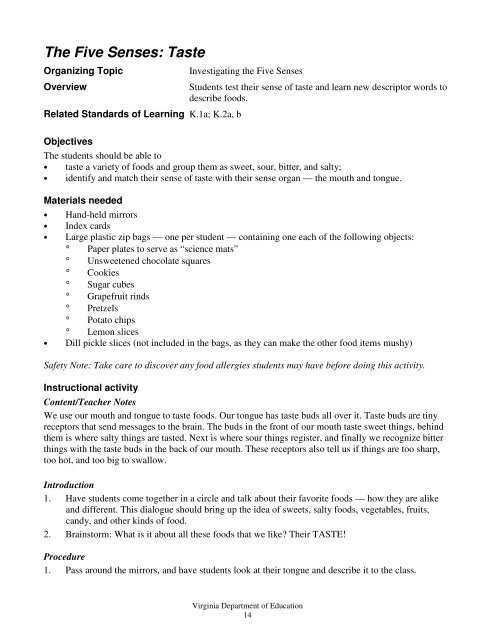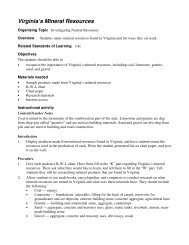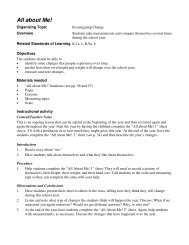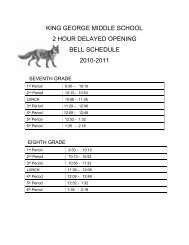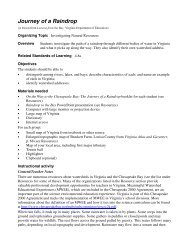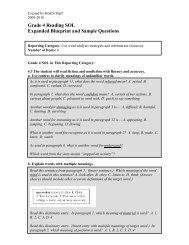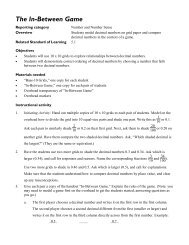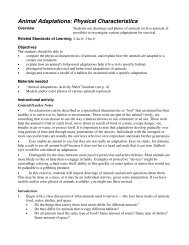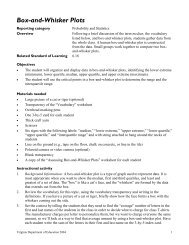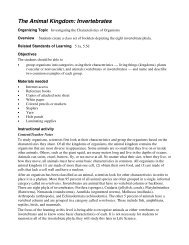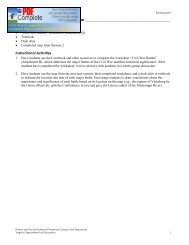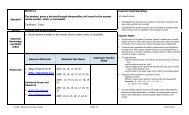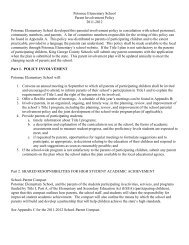Organizing Topic â Investigating the Five Senses
Organizing Topic â Investigating the Five Senses
Organizing Topic â Investigating the Five Senses
Create successful ePaper yourself
Turn your PDF publications into a flip-book with our unique Google optimized e-Paper software.
The <strong>Five</strong> <strong>Senses</strong>: Taste<br />
<strong>Organizing</strong> <strong>Topic</strong><br />
Overview<br />
Related Standards of Learning K.1a; K.2a, b<br />
<strong>Investigating</strong> <strong>the</strong> <strong>Five</strong> <strong>Senses</strong><br />
Students test <strong>the</strong>ir sense of taste and learn new descriptor words to<br />
describe foods.<br />
Objectives<br />
The students should be able to<br />
• taste a variety of foods and group <strong>the</strong>m as sweet, sour, bitter, and salty;<br />
• identify and match <strong>the</strong>ir sense of taste with <strong>the</strong>ir sense organ — <strong>the</strong> mouth and tongue.<br />
Materials needed<br />
• Hand-held mirrors<br />
• Index cards<br />
• Large plastic zip bags — one per student — containing one each of <strong>the</strong> following objects:<br />
° Paper plates to serve as “science mats”<br />
° Unsweetened chocolate squares<br />
° Cookies<br />
° Sugar cubes<br />
° Grapefruit rinds<br />
° Pretzels<br />
° Potato chips<br />
° Lemon slices<br />
• Dill pickle slices (not included in <strong>the</strong> bags, as <strong>the</strong>y can make <strong>the</strong> o<strong>the</strong>r food items mushy)<br />
Safety Note: Take care to discover any food allergies students may have before doing this activity.<br />
Instructional activity<br />
Content/Teacher Notes<br />
We use our mouth and tongue to taste foods. Our tongue has taste buds all over it. Taste buds are tiny<br />
receptors that send messages to <strong>the</strong> brain. The buds in <strong>the</strong> front of our mouth taste sweet things, behind<br />
<strong>the</strong>m is where salty things are tasted. Next is where sour things register, and finally we recognize bitter<br />
things with <strong>the</strong> taste buds in <strong>the</strong> back of our mouth. These receptors also tell us if things are too sharp,<br />
too hot, and too big to swallow.<br />
Introduction<br />
1. Have students come toge<strong>the</strong>r in a circle and talk about <strong>the</strong>ir favorite foods — how <strong>the</strong>y are alike<br />
and different. This dialogue should bring up <strong>the</strong> idea of sweets, salty foods, vegetables, fruits,<br />
candy, and o<strong>the</strong>r kinds of food.<br />
2. Brainstorm: What is it about all <strong>the</strong>se foods that we like? Their TASTE!<br />
Procedure<br />
1. Pass around <strong>the</strong> mirrors, and have students look at <strong>the</strong>ir tongue and describe it to <strong>the</strong> class.<br />
Virginia Department of Education<br />
14


